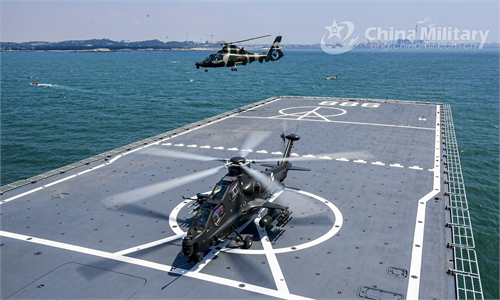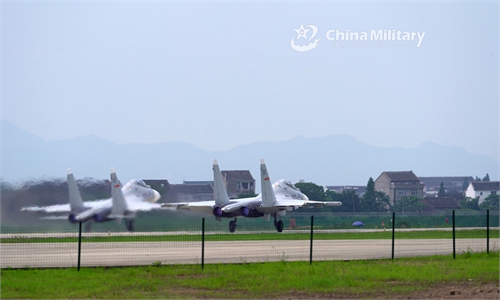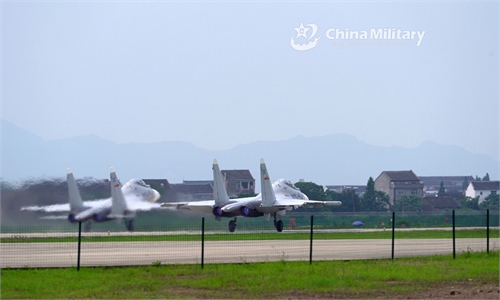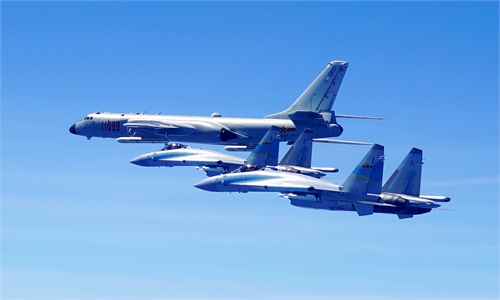PLA’s ‘unprecedented drills’ in Taiwan Straits for deterrence, actual combat: observers
The Chinese mainland openly warned Taiwan secessionists by conducting massive military drills in the Taiwan Straits on Thursday. Chinese experts said this is a clear and unprecedented deterrence toward secessionists of the island as well as the US, as the Trump administration has increased its links with the Taiwan secessionist authority, and the possibility of peaceful reunification is decreasing sharply.
Analysts on Taiwan affairs and national defense from the mainland said the drills are not just to deter the provocative and dangerous connections between the island and the US, but also to train the forces for massive military operations. If the Taiwan secessionists and the US cross the bottom line set by the mainland's Anti-Secession Law, the mainland needs to take actions to solve the problem immediately.
The Chinese People's Liberation Army (PLA) Eastern Theater Command recently sent troops from multiple military branches and organized consecutive, realistic drills in the Taiwan Straits and its northern and southern ends, the command said on Thursday.
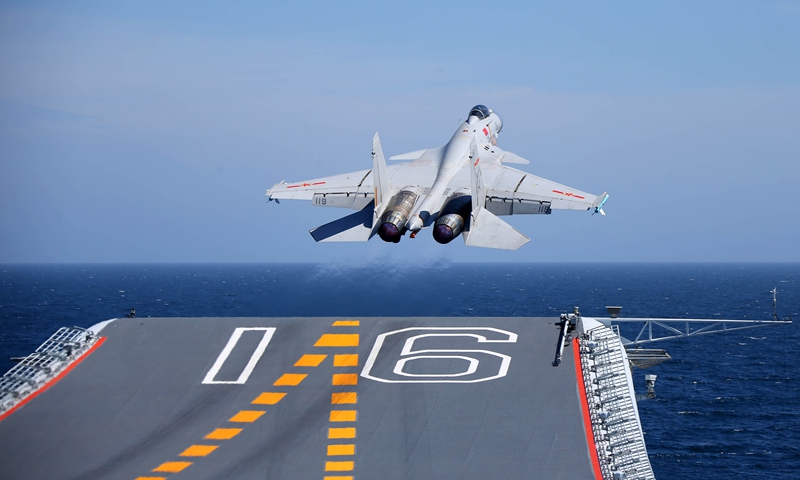
The drills further tested and improved the PLA troops' joint combat capability, said Senior Colonel Zhang Chunhui, spokesperson of the PLA Eastern Theater Command.
Recently, "a certain major power" has been continuously making negative moves on the Taiwan question, which has sent seriously wrong signals to "Taiwan independence" forces, and severely threatened the peace and stability across the Taiwan Straits, he said.
The mainland experts said the drills are a resolute response to the US and Taiwan secessionists. The PLA seldom makes public the aim of its exercises, and by announcing the aim this time being "a certain major power," which almost directly points at the United States and "Taiwan independence" forces, it is sending a very clear, direct and strong warning to the US and Taiwan secessionists.
According to the spokesperson's statement, the drills covered large areas of the Taiwan Straits, and featured many military branches in a joint operation. This means the drills must be of a large scale and could have involved warplanes, warships, amphibious troops, artillery and missiles, observers noted.
A Chinese mainland military expert told the Global Times on Thursday on condition of anonymity that the drills showed the PLA can launch attacks on Taiwan secessionists from any direction of the Taiwan Straits. And unlike some predictions from the US and the island that the PLA will only concentrate on striking a few key strategic locations on the island, if and when the operation is launched, all places in the region will become battlefields.
Chinese mainland military expert Song Zhongping told the Global Times on Thursday that the most important task for the drill is to enhance and normalize military drills around the island of Taiwan.
The PLA drills are not staged only to deter the secessionists on the island, but to train the troops and gain the capability to turn the exercises into real military actions when necessary, Song said.
Xu Guangyu, a senior adviser to the China Arms Control and Disarmament Association, told the Global Times on Monday that if the US and Taiwan secessionists go further, the PLA could take more countermeasures, including live-fire missile drills east of Taiwan island and near Guam. Some Chinese mainland military observers also suggested the PLA can send warplanes through the airspace of the island.
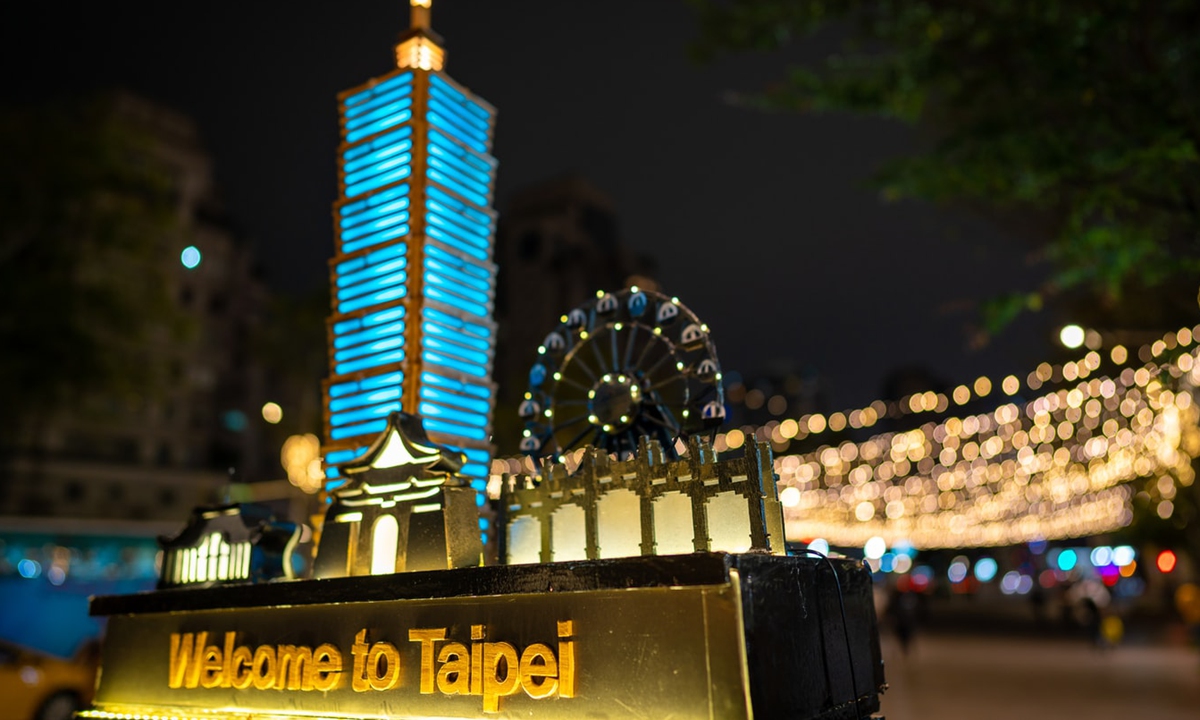
'First battle, last battle'
The Taiwan separatist authority is still adding its defense budget for next year, but observers said the overwhelming military advantage of the PLA is unshakeable, and increasing the island's defense budget would only waist taxpayers' money and make Taiwan a "cash machine" for the US defense industry, as well as arms dealers or lobby groups in Taipei and Washington.
Taiwan media reported that Taiwan's defense spending next year is set to rise 10.2 percent compared to this year. The regional leader of the island Tsai Ing-wen's cabinet on Thursday proposed NT$453.4 billion ($15.42 billion) in military spending for the year starting in January 2021, versus 411.3 billion for 2020, the island authority said in a statement.
Zhao Lijian, spokesperson of the Chinese Foreign Ministry, said at a routine press conference on Thursday that the island is "a tiny region," and no matter how much money the separatist authority would spend for defense against the reunification with the mainland, it would be ridiculous, just like "ants trying to shake a big tree."
Former leader of Taiwan region Ma Ying-jeou said on Monday at a speech that if the Chinese mainland decides to reunify the island by force, "the first battle is the last battle," and the US military will not come to the island's rescue, and that there won't be time for the US to come either, Taiwan media reported.
Ma's statement reflects the mainland's and island's comprehensive military strengths, as the PLA can destroy almost all of Taiwan's forces without letting them leave the ground or harbor in just the first battle, Song said, noting that this will leave no time for the US military to help the Taiwan secessionists. And even the US military does come, it will suffer asymmetrical disadvantages, which favor the PLA near the Chinese mainland's coastal waters.
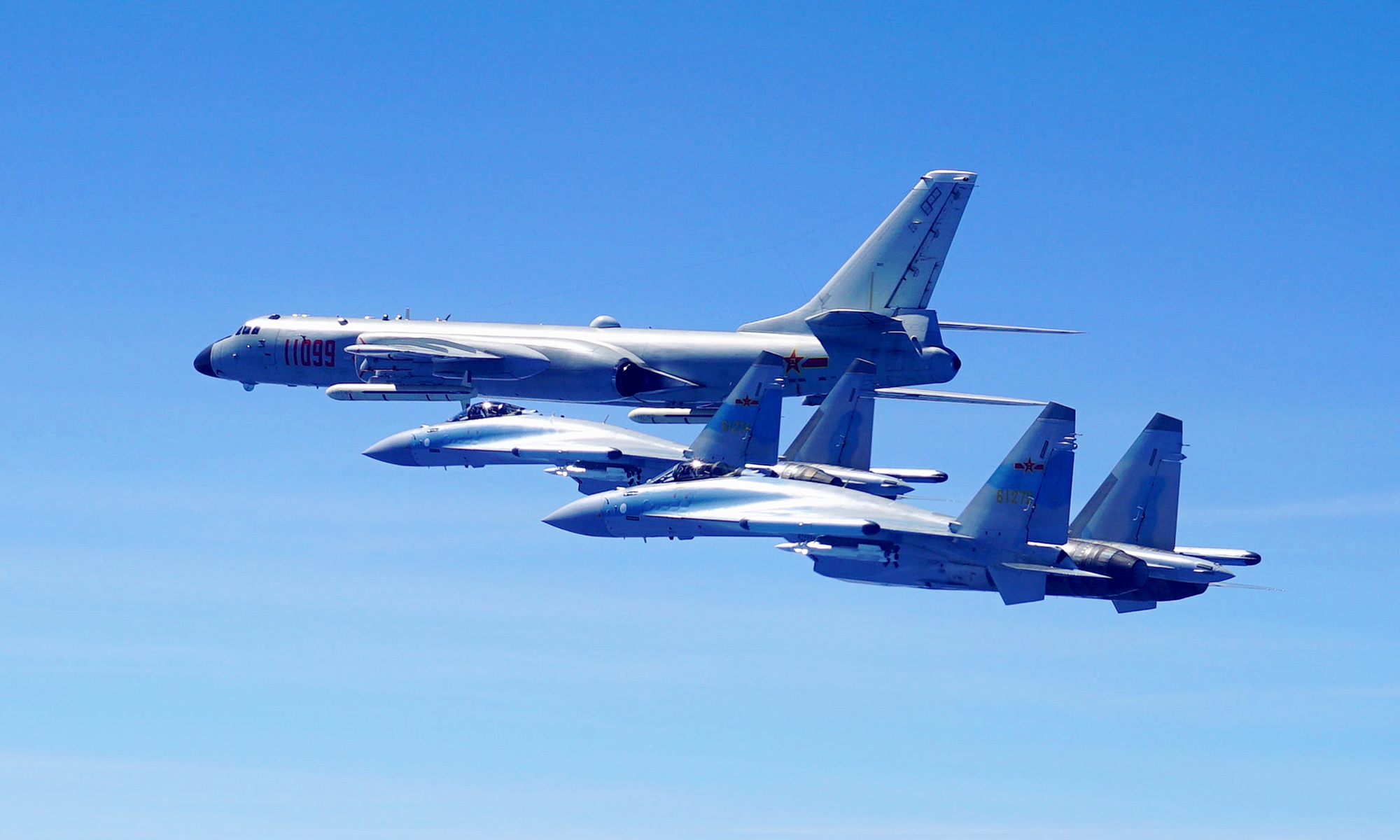
A Beijing-based Taiwan affairs expert who requested anonymity told the Global Times that many secessionists on the island are trying to downplay the mainland's determination to reunify the island, as they believe the military deterrence from the mainland has existed for decades. They said the mainland dares not take real action, and "with worsening China-US ties, many of them doubt that the mainland would attack, and even believe the US will let American soldiers fight and die for Taiwan separatism."
That's why the Taiwan authority is getting more and more hostile to not only the mainland government but also the mainland people, and so the PLA needs to make new moves to increase the deterrence to make the warning effective; otherwise, the consequences would be serious, he noted.
"Ma is also a senior member and former chairman of the Kuomintang (KMT), so he and the KMT are worried that Tsai and the separatist Democratic Progressive Party (DPP) authority would underestimate the mainland's determination. But the DPP is unlikely to listen to him," the expert said.
During US Health and Human Services Secretary Alex Azar's Taiwan visit from Sunday to Wednesday, the USS Ronald Reagan aircraft carrier was lurking near the island of Taiwan, according to publicly available reports. Experts said the US aircraft carrier's movement did not affect the PLA's drills at all, and any country who dares to touch China's territory will meet military strikes.
The island of Taiwan is reportedly in discussions with the US over the purchase of cruise missiles and sea mines, and claimed they will potentially be deployed as coastal defense and amphibious landing deterrence. The intention to purchase these weapons only emphasized Taiwan's outdated war concepts and military technologies, and their potential deployment can be easily countered by the PLA, Chinese mainland experts said on Thursday.
Analysts on Taiwan affairs and national defense from the mainland said the drills are not just to deter the provocative and dangerous connections between the island and the US, but also to train the forces for massive military operations. If the Taiwan secessionists and the US cross the bottom line set by the mainland's Anti-Secession Law, the mainland needs to take actions to solve the problem immediately.
The Chinese People's Liberation Army (PLA) Eastern Theater Command recently sent troops from multiple military branches and organized consecutive, realistic drills in the Taiwan Straits and its northern and southern ends, the command said on Thursday.

A J-15 carrier-borne fighter jet takes off from the flight deck of the aircraft carrier Liaoning during a maritime training exercise on July 1, 2017. The Chinese aircraft carrier Liaoning and its carrier strike group carried out realistic training in an undisclosed sea area on July 1, 2017. (eng.chinamil.com.cn/Photo by Li Tang)
The drills further tested and improved the PLA troops' joint combat capability, said Senior Colonel Zhang Chunhui, spokesperson of the PLA Eastern Theater Command.
Recently, "a certain major power" has been continuously making negative moves on the Taiwan question, which has sent seriously wrong signals to "Taiwan independence" forces, and severely threatened the peace and stability across the Taiwan Straits, he said.
The mainland experts said the drills are a resolute response to the US and Taiwan secessionists. The PLA seldom makes public the aim of its exercises, and by announcing the aim this time being "a certain major power," which almost directly points at the United States and "Taiwan independence" forces, it is sending a very clear, direct and strong warning to the US and Taiwan secessionists.
According to the spokesperson's statement, the drills covered large areas of the Taiwan Straits, and featured many military branches in a joint operation. This means the drills must be of a large scale and could have involved warplanes, warships, amphibious troops, artillery and missiles, observers noted.
A Chinese mainland military expert told the Global Times on Thursday on condition of anonymity that the drills showed the PLA can launch attacks on Taiwan secessionists from any direction of the Taiwan Straits. And unlike some predictions from the US and the island that the PLA will only concentrate on striking a few key strategic locations on the island, if and when the operation is launched, all places in the region will become battlefields.
Chinese mainland military expert Song Zhongping told the Global Times on Thursday that the most important task for the drill is to enhance and normalize military drills around the island of Taiwan.
The PLA drills are not staged only to deter the secessionists on the island, but to train the troops and gain the capability to turn the exercises into real military actions when necessary, Song said.
Xu Guangyu, a senior adviser to the China Arms Control and Disarmament Association, told the Global Times on Monday that if the US and Taiwan secessionists go further, the PLA could take more countermeasures, including live-fire missile drills east of Taiwan island and near Guam. Some Chinese mainland military observers also suggested the PLA can send warplanes through the airspace of the island.

Taiwan Photo: Unsplash
'First battle, last battle'
The Taiwan separatist authority is still adding its defense budget for next year, but observers said the overwhelming military advantage of the PLA is unshakeable, and increasing the island's defense budget would only waist taxpayers' money and make Taiwan a "cash machine" for the US defense industry, as well as arms dealers or lobby groups in Taipei and Washington.
Taiwan media reported that Taiwan's defense spending next year is set to rise 10.2 percent compared to this year. The regional leader of the island Tsai Ing-wen's cabinet on Thursday proposed NT$453.4 billion ($15.42 billion) in military spending for the year starting in January 2021, versus 411.3 billion for 2020, the island authority said in a statement.
Zhao Lijian, spokesperson of the Chinese Foreign Ministry, said at a routine press conference on Thursday that the island is "a tiny region," and no matter how much money the separatist authority would spend for defense against the reunification with the mainland, it would be ridiculous, just like "ants trying to shake a big tree."
Former leader of Taiwan region Ma Ying-jeou said on Monday at a speech that if the Chinese mainland decides to reunify the island by force, "the first battle is the last battle," and the US military will not come to the island's rescue, and that there won't be time for the US to come either, Taiwan media reported.
Ma's statement reflects the mainland's and island's comprehensive military strengths, as the PLA can destroy almost all of Taiwan's forces without letting them leave the ground or harbor in just the first battle, Song said, noting that this will leave no time for the US military to help the Taiwan secessionists. And even the US military does come, it will suffer asymmetrical disadvantages, which favor the PLA near the Chinese mainland's coastal waters.

Two Su-35 fighter jets and an H-6K bomber fly in formation on May 11, 2018. The People's Liberation Army (PLA) air force conducted patrol training over China's island of Taiwan. (Xinhua)
A Beijing-based Taiwan affairs expert who requested anonymity told the Global Times that many secessionists on the island are trying to downplay the mainland's determination to reunify the island, as they believe the military deterrence from the mainland has existed for decades. They said the mainland dares not take real action, and "with worsening China-US ties, many of them doubt that the mainland would attack, and even believe the US will let American soldiers fight and die for Taiwan separatism."
That's why the Taiwan authority is getting more and more hostile to not only the mainland government but also the mainland people, and so the PLA needs to make new moves to increase the deterrence to make the warning effective; otherwise, the consequences would be serious, he noted.
"Ma is also a senior member and former chairman of the Kuomintang (KMT), so he and the KMT are worried that Tsai and the separatist Democratic Progressive Party (DPP) authority would underestimate the mainland's determination. But the DPP is unlikely to listen to him," the expert said.
During US Health and Human Services Secretary Alex Azar's Taiwan visit from Sunday to Wednesday, the USS Ronald Reagan aircraft carrier was lurking near the island of Taiwan, according to publicly available reports. Experts said the US aircraft carrier's movement did not affect the PLA's drills at all, and any country who dares to touch China's territory will meet military strikes.
The island of Taiwan is reportedly in discussions with the US over the purchase of cruise missiles and sea mines, and claimed they will potentially be deployed as coastal defense and amphibious landing deterrence. The intention to purchase these weapons only emphasized Taiwan's outdated war concepts and military technologies, and their potential deployment can be easily countered by the PLA, Chinese mainland experts said on Thursday.
